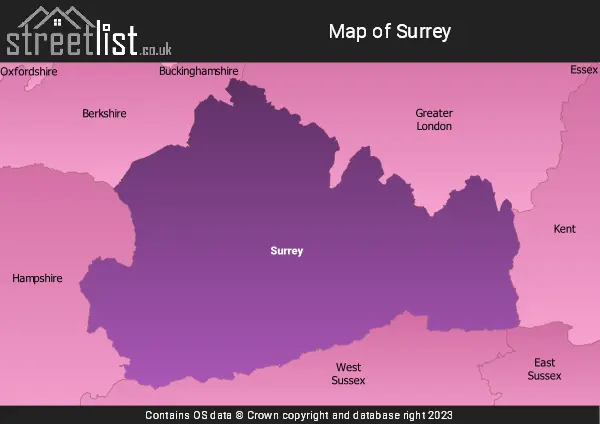The Ceremonial County of Surrey is situated in South East England.

The area of Surrey is 645 Square Miles (1,670 Square Kilometres). Making Surrey the 37th smallest county in Great Britain (out of 91) and the 14th smallest county in England (out of 48).
The Saxons divided southern England into four tribes: the East Saxons (Essex), South Saxons (Sussex), West Saxons (Wessex), and Middle Saxons. Surrey derives its name from the southern part of the Middle Saxon territory, meaning 'southern region,' while the northern area became Middlesex.
Surrey's ancient roads include the Pilgrims' Way, crossing the county through Farnham and Dorking on the route to Canterbury. Stane Street, the Roman road from London to Chichester, also ran through Dorking. The county has long been connected to London, and William Shakespeare even built the original Globe Theatre in Surrey (Bankside, then part of Surrey, built in 1599).
The chalk ridge known as the Hogs Back runs east to west, bisecting the county. The area west of the River Wey and north of the Hogs Back was once part of Windsor Forest, a royal hunting ground.
Surrey historically fell under the jurisdiction of the Bishop of Winchester until 1877. Today, Guildford, with its modern cathedral, is the county town, though earlier Surrey's administrative centres were Newington and Kingston upon Thames, now part of Greater London.
Surrey was divided into 14 Hundreds, including Farnham, Woking, Godalming, Reigate, and Kingston. Modern Surrey differs significantly from its historical borders, with much of south London, including Surrey Quays in Rotherhithe, formerly part of the county.
During the English Civil War, Surrey largely supported Parliament, contributing to its success with iron foundries and gunpowder works at Chilworth. However, the county faced heavy taxes and losses. In 1648, the Earl of Holland led a brief insurrection, clashing with Parliamentary forces at Surbiton.
Surrey's economy once thrived on iron and cloth, but agriculture grew as London's demand for food increased. The River Wey was canalised in 1653, becoming one of England's first navigable waterways. As London expanded, much of Surrey was absorbed into its suburbs.

A map showing the geology of Surrey.
| Map Key | Description |
|---|---|
| 21 | MUDSTONE, SILTSTONE AND SANDSTONE |
| 28 | SAND, SILT AND CLAY |
| 30 | CHALK |
| 48 | MUDSTONE, SANDSTONE AND LIMESTONE |
| 57 | SANDSTONE AND MUDSTONE |
| 76 | SANDSTONE AND SILTSTONE, INTERBEDDED |
| 79 | CLAY, SILT, SAND AND GRAVEL |

A map showing the boundary of Surrey in relation to other counties.
Map of the County of Surrey
| Zoom Level | Latitude | Longitude |
| 6 | 53.521968 | -2.164306 |